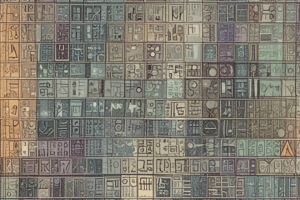Podcast
Questions and Answers
What is the relationship between the numerator and denominator of an equivalent fraction?
What is the relationship between the numerator and denominator of an equivalent fraction?
- The numerator and denominator have no relationship
- The numerator is always larger than the denominator
- The numerator is always a factor of the denominator
- There exists an integer k such that k times one fraction equals the other fraction (correct)
What is the first step in adding two fractions with different denominators?
What is the first step in adding two fractions with different denominators?
- Find the greatest common factor of the denominators
- Convert the fractions to have a common denominator (correct)
- Multiply the numerators and denominators together
- Add the numerators and keep the original denominators
What is the purpose of the Butterfly Method when adding fractions?
What is the purpose of the Butterfly Method when adding fractions?
- To convert the fractions to have a common denominator (correct)
- To find the greatest common factor of the denominators
- To add the numerators and keep the original denominators
- To reinforce misconceptions about fractions
What is the difference between a proper fraction and an improper fraction?
What is the difference between a proper fraction and an improper fraction?
What is the result of multiplying two fractions?
What is the result of multiplying two fractions?
How do you divide one fraction by another fraction?
How do you divide one fraction by another fraction?
What is the result of subtracting 2/3 from 4/3?
What is the result of subtracting 2/3 from 4/3?
When multiplying fractions, what is the first step?
When multiplying fractions, what is the first step?
What is the reciprocal of 5/7?
What is the reciprocal of 5/7?
If you divide 4/5 by 2/3, what will be the result?
If you divide 4/5 by 2/3, what will be the result?
What should be done to add or subtract fractions with different denominators?
What should be done to add or subtract fractions with different denominators?
If you multiply 2/3 by 4/5, what is the product?
If you multiply 2/3 by 4/5, what is the product?
Flashcards are hidden until you start studying
Study Notes
Fractions
In mathematics, fractions play a vital role in understanding measurements and relationships between quantities. They consist of two parts: the numerator, which represents the number of equal parts taken from a whole, and the denominator, which denotes the total number of equal parts the whole is divided into. Fractions can either be proper (less than 1) or improper (greater than or equal to 1).
Equivalent Fractions
Equivalent fractions represent the same ratio of two integers. Two fractions are considered equivalent if there exists an integer k such that k times one fraction equals another fraction. For example, 3/6 and 1/2 are equivalent fractions since 3*1/6 = 1/2. Knowing the relationship between equivalent fractions helps students understand patterns and properties of fractions better.
Adding Fractions
Addition of fractions involves combining two or more fractions that have a common denominator (the bottom term in the fraction notation). Different methods can be used to perform this operation. One approach is to find a common denominator, align the fractions based on their place value, and then combine the numerators of the aligned fractions. For example, to add 3/8 and 2/8, we can rewrite them as 3/8 + 2/8 = 5/8.
Another method is the Butterfly Method, which uses repeated long division to find a common multiple of the denominators. However, this method is not recommended for young students as it may reinforce misconceptions about fractions.
Subtracting Fractions
Subtraction involves finding the difference between two fractions. Similar to addition, subtraction requires having a common denominator. To subtract 3/8 minus 2/8, we can write it as 3/8 - 2/8 = 1/8.
Multiplying Fractions
To multiply fractions, we multiply the numerators and then the denominators. For example, to multiply 3/8 and 2/4, we can write it as (3 * 2)/(8 * 4) = 3/16. Multiplication helps to understand the relationship between fractions and the product generated through this process.
Dividing Fractions
Division of fractions involves taking a divisor (a fraction or a rational number) and dividing it by a dividend (also a fraction or a rational number), producing a quotient. The quotient is a fraction. For example, to divide 3/8 by 2/8, we can write it as (3/8) / (2/8) = 1/2. Division helps to understand the meaning of reciprocal relationships between fractions.
Understanding these operations with fractions is essential for further advancements in mathematics, particularly in areas related to algebra, geometry, and trigonometry.
Studying That Suits You
Use AI to generate personalized quizzes and flashcards to suit your learning preferences.



